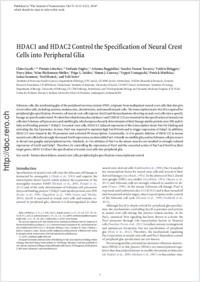HDAC1 and HDAC2 Control the specification of neural crest cells into peripheral glia
- Jacob, Claire Institute of Molecular Health Sciences, Department of Biology, ETH Zurich, Switzerland - Institute of Zoology, Department of Biology, University of Fribourg, Switzerland
- Lötscher, Pirmin Institute of Molecular Health Sciences, Department of Biology, ETH Zurich, Switzerland
- Engler, Stefanie Institute of Molecular Health Sciences, Department of Biology, ETH Zurich, Switzerland - Institute of Zoology, Department of Biology, University of Fribourg, Switzerland
- Baggiolini, Arianna Institute of Anatomy, University of Zurich, Switzerland
- Tavares, Sandra Varum Institute of Anatomy, University of Zurich, Switzerland
- Brügger, Valérie Institute of Zoology, Department of Biology, University of Fribourg, Switzerland
- John, Nessy Institute of Anatomy, University of Zurich, Switzerland
- Büchmann-Møller, Stine Institute of Anatomy, University of Zurich, Switzerland
- Snider, Paige L. Developmental Biology and Neonatal Medicine Program, Indiana University School of Medicine, Indianapolis, USA
- Conway, Simon J. Developmental Biology and Neonatal Medicine Program, Indiana University School of Medicine, Indianapolis, USA
- Yamaguchi, Teppei FMI for Biomedical Research, Novartis Research Foundation, Basel, Switzerland
- Matthias, Patrick FMI for Biomedical Research, Novartis Research Foundation, Basel, Switzerland
- Sommer, Lukas Institute of Anatomy, University of Zurich, Switzerland
- Mantei, Ned Institute of Molecular Health Sciences, Department of Biology, ETH Zurich, Switzerland
- Suter, Ueli Institute of Molecular Health Sciences, Department of Biology, ETH Zurich, Switzerland
-
23.04.2014
Published in:
- The Journal of Neuroscience. - 2014, vol. 34, no. 17, p. 6112–6122
English
Schwann cells, the myelinating glia of the peripheral nervous system (PNS), originate from multipotent neural crest cells that also give rise to other cells, including neurons, melanocytes, chondrocytes, and smooth muscle cells. The transcription factor Sox10 is required for peripheral glia specification. However, all neural crest cells express Sox10 and the mechanisms directing neural crest cells into a specific lineage are poorly understood. We show here that histone deacetylases 1 and 2 (HDAC1/2) are essential for the specification of neural crest cells into Schwann cell precursors and satellite glia, which express the early determinants of their lineage myelin protein zero (P0) and/or fatty acid binding protein 7 (Fabp7). In neural crest cells, HDAC1/2 induced expression of the transcription factor Pax3 by binding and activating the Pax3 promoter. In turn, Pax3 was required to maintain high Sox10 levels and to trigger expression of Fabp7. In addition, HDAC1/2 were bound to the P0 promoter and activated P0 transcription. Consistently, in vivo genetic deletion of HDAC1/2 in mouse neural crest cells led to strongly decreased Sox10 expression, no detectable Pax3, virtually no satellite glia, and no Schwann cell precursors in dorsal root ganglia and peripheral nerves. Similarly, in vivo ablation of Pax3 in the mouse neural crest resulted in strongly reduced expression of Sox10 and Fabp7. Therefore, by controlling the expression of Pax3 and the concerted action of Pax3 and Sox10 on their target genes, HDAC1/2 direct the specification of neural crest cells into peripheral glia.
- Faculty
- Faculté des sciences et de médecine
- Department
- Département de Biologie
- Language
-
- English
- Classification
- Biological sciences
- License
- License undefined
- Identifiers
-
- RERO DOC 209897
- DOI 10.1523/JNEUROSCI.5212-13.2014
- Persistent URL
- https://folia.unifr.ch/unifr/documents/303571
Statistics
Document views: 136
File downloads:
- jac_hhc.pdf: 222
